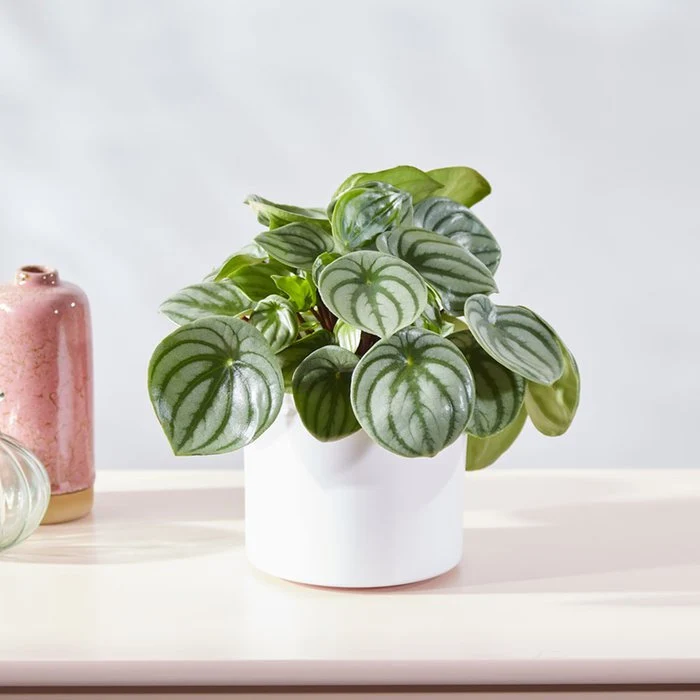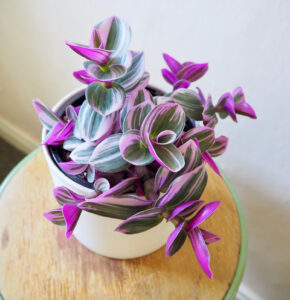Introduction
Watermelon Peperomia (Peperomia argyreia) is a delightful houseplant beloved for its unique, showy foliage. Named for its striking leaves that resemble watermelon rinds—oval-shaped with silver and dark green stripes—this compact, low-maintenance plant is ideal for desktops, shelves, or bright corners of the home.
Native to the rainforests of South America, particularly Brazil, Watermelon Peperomia belongs to a large genus of over 1,000 Peperomia species. Though often mistaken for succulents, they’re actually more like tropical perennials, thriving in warm, humid environments.
Let’s dive into how to keep this stunner looking fresh and fabulous!
1. Light Requirements
Bright, Indirect Light is key.
- Ideal Placement: Near an east- or north-facing window, or a few feet back from a bright south or west window. It loves light, but direct sunlight can scorch the leaves.
- Too Little Light: Leads to leggy growth and faded leaf color.
- Too Much Light: Causes leaf burn, especially along the silver stripes.
Grow Lights: If natural light is limited, fluorescent or LED grow lights work well.
2. Watering Needs
Watermelon Peperomia likes a balance—not too wet, not too dry.
- When to Water: Water when the top 1–2 inches of soil feel dry. Stick your finger in—if it feels dry up to the first knuckle, it’s time to water.
- How to Water: Water thoroughly until water drains from the bottom. Discard excess water—never let it sit in soggy soil.
- Seasonal Adjustments: In winter, reduce watering frequency as the plant’s growth slows.
Signs of Overwatering:
- Yellowing, mushy leaves
- Wilting despite wet soil
- Root rot (foul smell, blackened roots)
Signs of Underwatering:
- Wrinkled or drooping leaves
- Dry soil pulling away from the pot edges
3. Soil and Potting
Well-draining soil is a must.
- Best Mix: A blend of potting soil + perlite or orchid bark. You can use:
- 2 parts indoor potting mix
- 1 part perlite
- 1 part orchid bark or coarse sand
Why? Peperomias have fine roots that don’t like to sit in heavy, wet soil. Drainage is critical.
Pot Choice: Use a pot with drainage holes. Terracotta pots are great because they wick away excess moisture.
4. Temperature and Humidity
Watermelon Peperomia enjoys tropical, stable conditions.
- Temperature Range: 65–80°F (18–27°C)
- Avoid: Cold drafts, sudden temperature swings, and frost. Below 50°F (10°C) can cause leaf damage.
- Humidity: Prefers 50–60% humidity, but adapts to average home levels. In dry indoor air:
- Use a pebble tray
- Group with other plants
- Use a humidifier
5. Fertilizing
Light feeders by nature, but they’ll appreciate some nutrients.
- Frequency: Once a month during spring and summer. Skip feeding in fall and winter.
- Type of Fertilizer: A balanced liquid houseplant fertilizer (e.g., 10-10-10) diluted to half strength.
- Avoid Overfeeding: Can cause leaf burn or salt build-up.
6. Pruning and Maintenance
Minimal effort required!
- Pruning: Pinch back any leggy stems or remove damaged leaves to encourage bushier growth.
- Cleaning: Wipe leaves with a damp cloth to remove dust and keep them looking glossy.
Re-potting:
- Peperomias like being slightly root-bound. Repot every 2–3 years or if roots are circling the bottom.
- Spring is the best time to repot.
7. Pests and Problems
Generally pest-resistant, but occasional issues can arise.
Common Pests:
- Fungus gnats: Often due to overly moist soil.
- Spider mites or mealybugs: Treat with neem oil or insecticidal soap.
- Thrips: Look for discolored streaks or leaf curl.
Diseases:
- Root rot: Caused by overwatering.
- Leaf drop or curling: Often stress-related—check for drafts, dry air, or inconsistent watering.
8. Propagation
Super easy to propagate!
Leaf Cuttings:
- Cut a healthy leaf with a short stem (petiole).
- Let it dry for a few hours to form a callus.
- Plant in moist soil or place in water.
- Roots appear in 2–4 weeks.
Stem Cuttings:
- Take a short section with at least one leaf and node.
- Place in soil or water. Once rooted, transplant to a small pot.
Tip: Cover new cuttings with a plastic dome or bag to boost humidity for faster rooting.
9. Growth and Appearance
- Mature Size: 6–12 inches tall and wide.
- Growth Habit: Clumping, compact, and bushy.
- Flowers: Produces small, greenish “rat-tail” flowers on spikes—not showy, but a sign of a healthy plant.
- Leaves: Rounded, striped, and held on reddish stems.
10. Toxicity and Safety
Non-toxic to cats and dogs!
Watermelon Peperomia is pet-safe, making it a great option for homes with furry friends.
11. Styling and Display
Because of its compact size and beautiful foliage, Watermelon Peperomia is perfect for:
- Desktops and bookshelves
- Hanging baskets or elevated planters
- Tropical groupings with ferns, calatheas, or philodendrons
- Modern and minimalist interiors as a living decor piece
Use decorative pots that complement its leaf patterns—whites, blacks, or natural ceramics make the foliage pop.
Conclusion
Watermelon Peperomia is a superstar plant that delivers big style with minimal fuss. With its eye-catching striped leaves and compact form, it brings a pop of personality to any space. It’s especially great for beginners or plant lovers who want a tropical look without the high-maintenance needs of fussier foliage.
Just give it bright, indirect light, water when the soil’s dry, and keep it out of direct sun or cold drafts, and you’ll enjoy its vibrant beauty year-round.


